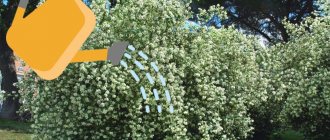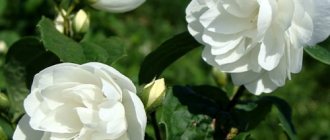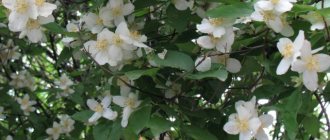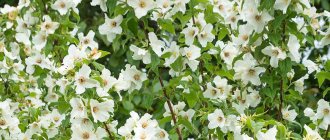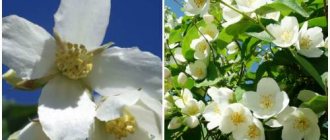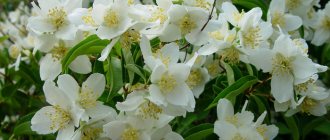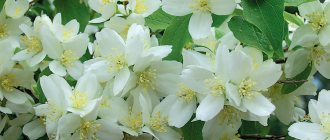Plants in the thicket family are often called garden jasmine or false jasmine. These are ornamental shrubs with bright, often white flowers and a delicate aroma, in some varieties reminiscent of jasmine.
But among other species of this family, the Lemoine hibiscus occupies an honorable place.
This plant will look good in a garden with lilacs.
Description
Mock orange Lemoine is a beautiful shrub plant belonging to the Hydrangeaceae family. This hybrid category appeared in the 19th century thanks to the French breeder V. Lemoine. Most common in Europe and North America. The plant is a lush bush, reaching 3 meters in height. It is often confused with jasmine, but apart from the pleasant aroma of flowers, there are no common features. The ovoid, lanceolate leaves reach a length of 4 centimeters. The inflorescences are presented in racemes in which large white flowers are collected. Each inflorescence contains 5-7 flowers.
Chubushnik Lemoine - description of the plant
The most popular plants are:
- Glacier mock orange;
- mock orange Charm;
- mock orange Snow storm.
The most famous varieties
The diversity of mock oranges bred by Lemoine is explained by the fact that work was carried out in three directions:
- breeding original non-double varieties of shrubs, characterized by abundant flowering and unique aroma;
- creation of double and semi-double varieties of mock orange;
- breeding plants that have purple spots on their flowers.
Victor Lemoine created his first variety by crossing the common mock orange (Philadelphus coronaries) and the small-leaved mock orange (Philadelphus microphyllus). As a result of this interspecific hybridization, the first result was obtained in 1883: a frost-resistant, stable, highly ornamental shrub, blooming with white fragrant flowers with wavy petals. This plant later served as the basis for four dozen unique Lemoine mock oranges. Time and fashion make their own adjustments; different forms of this ornamental shrub become popular in different years. Let's look at the description of the Lemoine mock orange varieties that are most famous these days.
Alabaster
The bush is not tall, up to one and a half meters, and has strong straight stems with numerous lateral branches bearing large elongated inflorescences with 7-11 flowers. The size of the flowers is quite large - up to 5.5 cm. They are formed by wide bright white petals. The flowers are simple, sometimes semi-double, with a strong scent. The variety blooms in the last ten days of June, flowering continues for about a month.
The flowers of the Alabaster variety are surprisingly delicate
White bouquet (Bouquet Blanche)
This variety is also low, no more than 1.5 meters. Its bush is literally strewn with large double flowers with a diameter of 5 cm. The lower row of the corolla is formed by wide petals, and the inner part of the flower can contain up to 30 petals, arranged in several rows. This variety of Lemoine mock orange is amazingly beautiful, but it is better to grow it in places where there are no harsh winters. In the conditions of central Russia, it can sometimes freeze slightly, so it often blooms on the lower branches.
Recommendation. When growing this variety, it is advisable to plant it in a place protected from the north wind and cover it for the winter.
Ermine mantle (Monteau d'Hermine)
The height of this spreading shrub, formed by many shoots, is 80, rarely 100 cm. The inflorescences are formed by 2-3 medium-sized double flowers and are located along the entire length of the shoot. Flowering begins at the usual time for mock orange and continues for more than a month. During this period, the hanging branches, abundantly strewn with fluffy flowers, really resemble a flowing mantle. The Lemoine mock orange of this variety looks very impressive.
Bicolor (Bicolore) and Pink Star (Etoile Rose)
These two varieties, bred at the beginning of the 19th century, marked the appearance of “pink” mock oranges.
Information for the curious. Before the appearance of Lemoine varieties, both in nature and in culture, there were plants with only white flowers or flowers with a faint cream tint.
Both varieties have low bushes 80-100 cm, with simple flowers. But their distinctive feature is the pink or purple shades of the central part. In the bell-shaped Pink Star flower, the color clearly thickens towards the center and the plant looks bright and impressive. The Bicolor variety is not so bright. But the pink-colored middle of the larger flower, combined with lush stamens and airy petals, creates an unusually delicate and touching appearance of the shrub.
Beautiful Star (Belle Etoile)
Lemoine's mock orange Belle Etoile, which means beautiful star, can be called, without exaggeration, one of the masterpieces of the maestro's selection. The height of a compact bush with erect stems in our conditions usually does not exceed a meter; in warmer climates it grows up to one and a half meters. The flowers are slightly larger than average, approximately 4 cm in diameter with a bright purple-pink spot in the center. They look impressive against the background of small, inconspicuous foliage. The faint strawberry aroma of the flowers of this variety complements the impression of magic. Although the plant may freeze in a snowless winter, it quickly recovers.
Isn't it true, he is simply amazing!
Advice to a florist. There is no need to rely on the weather and worry about the lack of snow. Lightly covering this low bush with spruce branches is a simple solution to the problem.
Mont Blanc
The snow-white crown, strict snow-white flowers, covering the bush reminded the creators of the variety of a snowy peak - hence the name. There are 3-4 flowers in an inflorescence, they grow close to each other. The very wide petals of the lower row are located closely, without gaps, forming a square-shaped flower. The few inner petals are turned towards the stamens. Each flower looks very elegant, and the whole bush looks very luxurious. It blooms from mid to late June and blooms for up to forty days.
Enchantment
The erect stems of the luxurious shrub bear lush, dense inflorescences of large double flowers. The spectacle is amazing. This mock orange Lemoine blooms about two weeks after the crown mock orange. Abundant flowering lasts for 25 days. Over time, the lower parts of the branches may become bare, so it is advisable to plant some kind of low-growing variety in the foreground.
Planting a plant
Mock orange virgin - description, planting and care
The seeds are soaked in water for several hours. After this, they are placed in moistened sawdust for 2 days. Before soaking, they should be wrapped in a light cloth. After swelling and germination, the seeds can be prepared for planting. In mock orange they are small, so before planting it is best to mix them with sand, and then place them in pre-prepared grooves and cover them with peat. Planting is also possible in the fall: for this, seeds are placed in prepared grooves and covered with dried grass. Shoots should appear in the spring.
Important! Philadelphus Lemoinei is a light-loving plant.
This representative of the plant world also thrives in areas with light partial shade. Completely shaded areas are undesirable, since in them the branches will begin to stretch, and the bush itself will lose its decorativeness and compactness.
Planting in open ground
Planting seedlings in open ground
The optimal time for planting is spring or autumn. In the second case, there must be at least 20 days left before frost, otherwise the bush will not be able to take root before the cold weather arrives.
Mock orange snowbel - description, planting and care
Mock orange is undemanding to soil conditions. Only it cannot be placed on swampy or saline soil. The planting pit is prepared in advance. Its size is 50x60 centimeters. At the bottom there must be a drainage layer and a mixture of garden soil with sand, humus or compost. Additives depend on soil type. When planting several specimens, the distance between the holes should be around 1-1.5 meters.
Remember! When planting, the root collar should be deepened no more than 3 centimeters. Otherwise, rotting may occur. The majority of varieties have sufficient winter hardiness. They can withstand temperatures down to -25°C.
The best varieties of mock orange for the middle zone
Probably every gardener knows mock orange or, as it is more often called, jasmine for the similarity of its aroma to southern shrubs. Unlike southern jasmines, mock orange is more winter-hardy and many of its varieties tolerate midland winters well.
The mock orange varieties bred by Professor Vekhov are especially resistant They differ in the height and shape of the bush, the degree of terry and the size of the flowers, as well as the timing of flowering. In central Russia, you can choose mock orange varieties in such a way that the flowering of this beautiful shrub will last for two months - in June and July.
Read also: Which type of lining is better
The Snow Avalanche variety is the first to bloom. Then, from the 2nd decade of June - “Airborne Landing”. At the beginning of July, “Akademik Komarov” picks up the baton and “Ballet of Moths” completes its flowering. The flowering duration of each variety ranges from 20 days to a month, so you will fully enjoy this enchanting spectacle.
How to care for Lemoine mock orange
Watering
For good development of the shrub, proper watering is necessary. Young mock oranges need to be moistened once a week. Adult specimens are watered with 15-25 liters of water. Frequency – once every 18-20 days. These recommendations are especially important during dry summers. If a period of heavy rain begins, watering stops. After moistening, loosen the soil and remove weeds.
Top dressing
Chubushnik shneeshturm - description, planting and care
A balanced fertilizer option is a solution of manure in water (1 to 10). This fertilizing is applied in the spring. One bucket is poured under the bush. At the end of the flowering period, wood ash is poured under the bush and leveled.
Reference. You can start applying complex mineral fertilizers only at the 4th year of life!
The proportions of fertilizers are as follows: for each bucket of water, 30 grams of superphosphate are used, as well as 15 grams of potassium sulfate and urea. This volume will be enough for 2 adult mock oranges. After the flowering period, 15 g of potassium sulfate and 25 g of superphosphate are used per square meter.
Trimming
Mock orange should be pruned regularly, otherwise the plant will lose its beauty and cease to please with its lush flowering. The fact is that flowers appear on strong and healthy branches from last year. Flowers may appear on old or diseased branches, but they will be faded and small. Because of this feature, pruning is carried out after flowering has completed. Faded branches are removed before the new shoots of this year. Most often they are located below the trimmed branches.
How to trim correctly
Reference. After a little time, the young branches will begin to grow actively, and dense flowering will begin the next year.
In autumn, sanitary pruning is carried out. Sick and damaged branches are removed, as well as branches that make the bush too dense. Branches older than 12 years are cut out every 3 years. This rejuvenating procedure is carried out in early spring, before sap flow begins. Strong trunks are shortened to 30 centimeters, and all others - to ground level.
Remember! All cuts must be soaked in garden varnish, and the soil must be loosened and mulched. Such measures will ensure strong young shoots and prevent the occurrence of certain diseases.
Reproduction
Mock orange lemoinei reproduces well vegetatively. Reproduction by seeds is also possible, but the use of this method is very doubtful. Flowering in such a plant begins only 5 or 6 years after planting in its permanent habitat, which is very bad. As for varietal characteristics and seed germination, everything is not very good here either. Seeds, as a rule, rarely retain parental and varietal characteristics, and their germination rate is low and short-lived.
Reproduction
The best options are the following propagation methods:
- cuttings;
- layering;
- division.
Cuttings
With the beginning of the first month of summer, green cuttings are cut off from the mock orange and rooted. When cutting, the green shoot should be left with part of the branch from last year's growth. There should be 2 pairs of leaves left on the cuttings. The top ones are cut by 1/3 or 1/2, and the bottom ones are completely removed.
Material for planting can be made in the fall. After this, it is placed in a regular bag and sent to the refrigerator until spring. Starting from the 2nd half of March, blanks 5 centimeters long are cut from these shoots. After this, they need to be kept in a solution of a root-forming stimulant for one day.
Cuttings
To root, cuttings must be buried in sandy soil or sand in the open air. Another option is to use a potty. For good rooting you will need warmth, soil and air with high humidity. To achieve all these conditions, a mini-greenhouse is suitable.
Advice. An ordinary plastic bottle is suitable for making a mini-greenhouse. To do this, you need to cut it in half and take the upper part. After planting the cutting, cover it with this part, not forgetting to unscrew the lid to allow air to enter.
Rooted cuttings will make excellent seedlings by next spring.
Reproduction methods
When using seeds, it should be taken into account that they do not fully convey varietal characteristics. Various variations may occur. The method is considered not the most successful, since flowering is possible only in the fifth year after planting.
Lemoine mock orange, for example, Philadelphus Lemoinei, is usually propagated vegetatively:
- cuttings;
- layering;
- dividing the bush.
Each method has its own characteristics. Green cuttings are cut and rooted. Each of them must have at least four leaves. The bottom plates should be removed. Before planting, the cuttings are dipped in a root-forming solution for a day. For rooting, they are buried in sand in a pot or in the open air. This process is facilitated not only by heat, but also by high humidity.
Important! To create a kind of greenhouse, you can use ½ of a plastic bottle. The lid must be unscrewed to allow air to enter.
The layering method is considered the simplest for propagating Lemoine mock oranges. The procedure begins in the spring. The selected branch is bent to the ground. At the junction, the bark is removed in a ring shape to a width of 1 cm. The cuttings must be attached to the soil using a wire arc, and then covered with soil, moistened and mulched.
Dividing the bush is important for overgrown specimens. Lemoine jasmine is dug up and divided using a sharp knife. The resulting plants are then planted.
Diseases and pests
Mock orange is a disease-resistant plant. Problems with it can arise due to harmful insects.
Diseases and pests
The most frequent guests on the plant:
- bean aphid;
- spider mite;
- green leaf weevil.
To exterminate aphids, the drugs Karbofos or Rogor are used, according to the instructions.
To get rid of spider mites, you will need a 3% Keltan emulsion or a 2% Phosfamide solution. These products should be sprayed on the plants and the soil underneath them. Frequency – 2-3 times with a break per week.
Remember! To remove the weevil and its offspring, you need to spray the soil and bushes with Chlorophos.
Preparing for winter
When the mock orange has finished blooming, it is prepared for wintering. Autumn pruning is carried out: diseased and dense branches are removed. After this, the mock orange is fed with phosphorus-potassium fertilizers and mulched. A thick layer of sawdust or peat is suitable for this.
The plant does not need shelter for the winter. As mentioned earlier, mock orange tolerates frosts down to -25°C. Even if some shoots freeze, the bush will not die. In spring, dead shoots are pruned to stimulate the growth of new shoots.
Use in landscape design
You can achieve harmony in landscape design by combining mock orange with hydrangea, viburnum or dogwood.
A special place is occupied by dwarf shrubs, such as “Gnome” and “Dwarf”. Such varieties are used as living borders, as well as edging flower beds and mixborders.
Use in landscape design
Mock oranges “Abundance”, “Chamomile”, “Avalanche” look very good in flower beds and mixborders. It is logical to use them in sensory gardens - aroma gardens, because of the wonderful smell of flowers.
For hedges, the varieties “Glacier”, “Moonlight”, and “Obelisk” are used.
Remember! The possibilities for using Lemoine mock orange in landscape design are enormous. The main thing to remember is that this is a fast-growing plant. Without proper care and rejuvenating procedures, it can quickly lose its decorative qualities.
Winter-hardy mock orange varieties for the Moscow region, the Urals and Siberia
Varieties from the Lemoine group: "Alabasrite" (Alabaster), "Gletcher" (Gletcher) and "MontBlanc" (Mont Blanc).
Vekhov varieties: “Arctic”, “Ballet of the Moths”, “Airborne”, “Gnome”, “Dwarf”. “Komsomolets”, “Moonlight”, “Pom-pom”, “Snow Avalanche”. "Snowstorm", "Yunnat".
In the conditions of the Moscow region, according to reviews from flower growers, almost all varieties of domestic selection grow and bloom well, they have successfully adapted to local conditions. Therefore, it is better to choose “Russian” varieties.
Varieties with an aroma reminiscent of strawberries
"Airborne", "Ermine Robe", "Avalanche", "Moonlight". "Mont Blanc", "Snow Storm", "Snow Avalanche", "Yunnat". And also small-leaved mock orange.
Varieties of two-color mock orange
The most popular varieties: "Beauclerk" (Beauclerk), "Bicolore" (Bicolor) and "Sybille" (Sibilla). However, at the moment they are not very common in Russia.
Dwarf varieties
The most popular varieties of dwarf mock oranges: “Dame Blanche” and “Manteau d'Hermine” or “Ermine Mantle” - up to 100 cm in height.
“Moonlight” – up to 70 cm. “Gnome” – up to 40 cm. “Dwarf” – up to 30 cm.
These varieties are often used to decorate rock gardens, edging borders or flower beds.
Chubushnik Vekhova Gnome
Beneficial features
The plant itself is not medicinal, but research is still underway. Essential oils, phytoncides, acids, vitamins C, E, PP and a small amount of glycosides were found in mock orange.
As a result, we get a plant with tonic, analgesic, antiseptic and regenerating properties. There are several traditional medicine recipes with this plant, but before using it, it is better to consult with a knowledgeable specialist.
Thus, mock orange is an amazing plant. Each species has a whole bunch of varieties, so choosing a plant to suit your purposes will not be difficult. Beautiful flowering and amazing aroma will not leave plant lovers aside!
